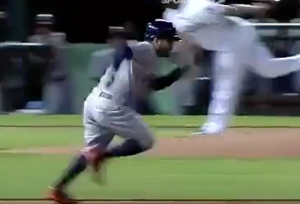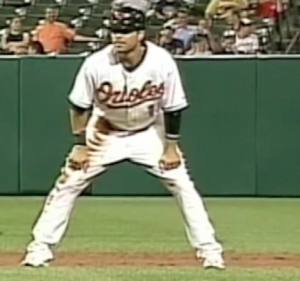5 Biggest Base Stealing Mistakes
Matt Talarico – StealBases.com
As a coach who is passionate about base stealing, I have learned to watch seemingly minor details become major factors in an athlete’s base stealing success. I am going to share the five biggest base stealing mistakes I see made the most. These are all basic and can be applied to any of our stealing methods (Old School, New School, or any Hybrid method). As a fast or slow base runner you must understand that aggressiveness will lead to close plays; these are plays we need to come out on the winning end of. The key to winning close plays is to pay attention to minor detail. Here are the five biggest mistakes I see:
Mistake 1: Set up and stance
Whenever I work with a new college team I am amazed to see the different running starts players have acquired over the years. Base stealing is often under-coached due to lack of understanding, which leads to players evolving on their own. This happens a few ways:
- Luck from previous attempts
- Applying coaching from other sports (how they run in football, track, etc.)
- Broscience – This is a weightlifting term used to describe your big, strong friend in the gym who told you how to lift. Then blindly taking it as gospel. So a fast teammate said he likes to do a leadoff like this then you just do what he said.
The biggest mistake I see with the setup and stance is players tend to squat too low. Squatting too low will cause issue with your initial jump or reactionary return to the base. It is almost like the runner gets stuck down in his legs and has to stand up to move. Notice how relaxed the runner is in the example below. This allows him to relax, which allows his body to move fluidly.
I love this setup from Canseco. He is very relaxed and has a very limited false step with his front foot. Although this is a natural movement we would like to limit the front foot losing a lot of ground. The wider your base, the more your body will naturally lose ground with that front foot before getting on line to run to second.
Keys to fixing mistakes in your setup:
- Stand in a relaxed position.
- Test yourself at different levels – how fast are you in your steal starts? Does this change when you modify your stance?
- Jump high and land – what position are you in? Does this position change when you get your leadoff? It shouldn’t.
Mistake 2: Passive Arm Action
Good runners understand the importance of our arms when we sprint. It is often overlooked by base stealers because we are focused on the timing of our jump and the efficiency of our legs to initiate the start. I challenge you to focus on your arms. We want our rear arm to rip across our body while our lead arm pulls back to the right fielder to create efficient footwork. Your legs will naturally match your arm action. This is working on acceleration from a leadoff (or squared to home) position vs. working on your top-end speed. There is a difference.
Here are some clips from an Altuve steal start:

Notice his rear arm across his body, which will eventually reach back. This should be a LONG lever in the back vs. a short 90 degree lever. This is the difference between acceleration technique and sprint form. Acceleration technique is a about exploding to top speed and sprinting is running for during top speed.
Here is Altuve at top-end speed. Arms are at a 90 degree angle, good high-knee position, etc. Much more detail on this coming in my next members only update later this month (hit the button below to sign up and receive much more information). But my point is to work on your acceleration.

Or Mitch Roman at top end speed:

If your arm movement during acceleration is inefficient than you are definitely hurting your time to second. Practice your start often.
Mistake #3: Run in a straight line
This one is frustrating. So many runners simply veer off line while they are running to second. Watch video of yourself or if you are a coach then watch your players from first during a game or a simulated steal in practice. You will be amazed at how many runners snake their way to second.
Tip to fix:
Find a focal point. I like telling our guys to start at the back of the back and end at the back of the bag. If you start at that focal point your will run in a better line to it.
Mistake #4: Looking like a threat
Good base stealers have a casual look to them when they are leading off. This especially applies to stealing third base. One of the easiest ways to get attention is to look like you need attention. I want ALL of my offensive players to be a base stealing threat so we never want to draw attention. Even if you aren’t stealing early in the game we may need you to swipe a bag later.
Here are some examples of my favorite player to watch (when he was still playing), Brian Roberts. He stole on all of these examples.
1st base:
 2nd base:
2nd base:

So many of our players look threatening and twitchy when they are thinking about running. You have to practice being an actor. This is a skill.
Mistake #5: Random Sliding
This is another one that drives me crazy but I realized early in my career that it was my fault and not the players because we weren’t practicing sliding in different situations.
Baseball players are copycats. They see their buddy looks good in an elbow guard and now everyone has an elbow guard, or Bryce Harper eye black or throws up signs after a double or whatever. We were all probably a little guilty of this. I remember seeing the greatest play at a high school game. I wasn’t in high school yet and a player I looked up to slid into home with a headfirst hook slide where the catcher swiped and missed him, for the next year a prayed to have such an opportunity. In fact, I was hook sliding every chance I had.
In reality your slide is dictated by the situation. Each player should be aware of all of his options and when to use them. Any wide slide variation will exchange the chance to dodge a tag for a sacrifice in speed (we are no longer in a straight line). So it is important that you practice plays with a defender showing different tag options so the runner can work on reacting with his different slide options. If a runner is going to be in a close play he should slide straight into the base vs. avoiding a tag that isn’t even there yet.
See the Old School system for details here:
Those are the 5 biggest mistakes I see that can be easily corrected. Again, they can be applied to our entire system and should be worked on every day. I love applying these to our warm-up routine. You are going to run some sprints to get your body going anyway you might as well work on accelerating from your leadoff into your sprints. You might mix in sliding at the end or using your focal points. This style of implementation can allow a small dose every single day of the year. By the end you will have made a base stealer who never commits these 5 common mistakes.
Learn more about our system by signing up at this link:
